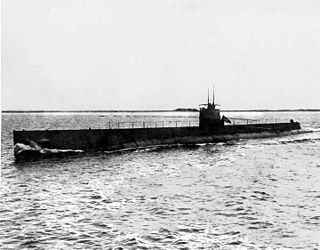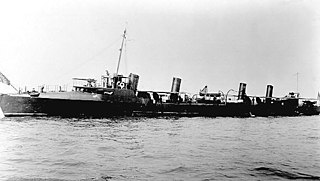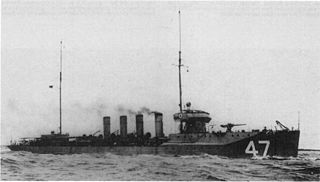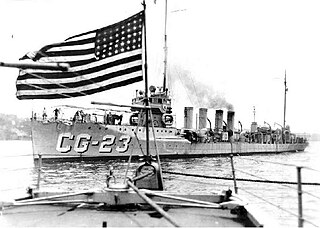
The first USS Chicago was a protected cruiser of the United States Navy, the largest of the original three authorized by Congress for the "New Navy" and one of the U.S. Navy's first four steel ships.

USS Dolphin (PG-24) was a gunboat/dispatch vessel; the fourth ship of the United States Navy to share the name. Dolphin was the first U.S. Navy ship to fly the flag of the president of the United States during President Chester A. Arthur's administration, and the second Navy ship to serve as a presidential yacht.

USS Barracuda (SF-4/SS-163), lead ship of her class and first of the "V-boats," was the second ship of the United States Navy to be named for the barracuda.

USS Mackerel (SS-204), the lead ship of her class of submarines, was the first ship of the United States Navy named for the mackerel. Mackerel and her near-sister Marlin were prototype small submarines which the Navy was exploring to replace the aging S-class submarines.

USS Bonita (SF-6/SS-165), a Barracuda-class submarine and one of the "V-boats," was the third ship of the United States Navy to be named for the bonito. Her keel was laid down by the Portsmouth Navy Yard. She was launched on 9 June 1925 as V-3 (SF-6), sponsored by Mrs. L.R. DeSteiguer, wife of Rear Admiral DeSteiguer, and commissioned on 22 May 1926, Lieutenant Commander Charles A. Lockwood, Jr. in command. Like her sisters, Bonita was designed to meet the fleet submarine requirement of 21 knots (39 km/h) surface speed for operating with contemporary battleships.

USS Marlin (SS-205), a Mackerel-class submarine, was the first ship of the United States Navy to be named for the marlin, a large game fish. Marlin and her near-sister Mackerel were prototype small submarines, which the Navy was exploring to replace the aging S-class submarines. References differ as to whether Marlin had a direct drive propulsion system or diesel-electric drive.

USS Bass (SF-5/SS-164), a Barracuda-class submarine and one of the "V-boats", was the first ship of the United States Navy to be named for the bass.

The Clemson class was a series of 156 destroyers which served with the United States Navy from after World War I through World War II.

The Wickes-class destroyers were a class of 111 destroyers built by the United States Navy in 1917–19. Together with the six preceding Caldwell-class and following 156 subsequent Clemson-class destroyers, they were grouped as the "flush-deck" or "four-stack" type. Only a few were completed in time to serve in World War I, including USS Wickes, the lead ship of the class.

The AA-1 class was a class of three experimental submarines of the United States Navy, built toward the end of World War I, between 1916 and 1919, intended to produce a high-speed fleet submarine. The design was not a success and none of the submarines saw active service. However, the lessons learned were applied to the design of the later V-boats. The class was later renamed as the T class.

Three Truxtun-class destroyers were built for the United States Navy. Part of the original 16 destroyers authorized by Congress on 4 May 1898 for the fiscal year 1899 program, they were commissioned in 1902. They were very similar to their Bainbridge-class contemporaries, except for mounting six 6-pounder (57 mm) guns instead of five. They were considered the most successful of the first 16 US Navy destroyers, and were succeeded by the larger Smith class.

The Bainbridge-class destroyers were a class of United States Navy Torpedo Boat Destroyers (TBDs) built between 1899 and 1903. The first class so designated, they comprised the first 13 of 16 TBDs authorized by Congress in 1898 following the Spanish–American War(the remaining three authorised comprised the Truxtun-class destroyers). One ship of the class was lost at sea during service in World War I: Chauncey, which collided with the British merchant ship SS Rose in 1917. The balance were decommissioned in 1919 and sold postwar in 1920, eleven to Joseph G. Hitner of Philadelphia, and the Hopkins to the Denton Shore Lumber Company in Tampa, Florida.

The Paulding-class destroyers were a series of United States Navy destroyers derived from the Smith class with the torpedo tubes increased from three to six via twin mounts. They were the first destroyers in the US Navy with oil-fired boilers. The 21 Pauldings doubled the number of destroyers in the US Navy. The Paulding class derived its name from the class's lead ship, Paulding, named for Rear Admiral Hiram Paulding (1797–1878). Like the Smiths, they were nicknamed "flivvers" after the small and shaky Model T Ford once the larger "thousand tonner" destroyers entered service.

Four destroyers in the United States Navy comprised the Cassin class. All served as convoy escorts during World War I. The Cassins were the first of five "second-generation" 1000-ton four-stack destroyer classes that were front-line ships of the Navy until the 1930s. They were known as "thousand tonners" for their normal displacement, while the previous classes were nicknamed "flivvers" for their small size, after the Model T Ford.

The Aylwin class was a class of four destroyers in the United States Navy; all served as convoy escorts during World War I. The Aylwins were the second of five "second-generation" 1000-ton four-stack destroyer classes that were front-line ships of the Navy until the 1920s. They were known as "thousand tonners". All were scrapped in 1935 to comply with the London Naval Treaty.

The Tucker class of destroyers was a ship class of six ships designed by and built for the United States Navy shortly before the United States entered World War I. The Tucker class was the fourth of five classes of destroyers that were known as the "thousand tonners", because they were the first U.S. destroyers over 1,000 long tons (1,016 t) displacement.

The Sampson-class destroyers served in the United States Navy during World War I. Commissioned in 1916 and 1917, the class was a modification of the O'Brien and Tucker classes, with the number of 21-inch (533 mm) torpedo tubes increased from four twin-mounts to four triple-mounts. The Sampsons were the final six ships of the 26 "thousand tonner" destroyers. They were the largest and most heavily armed of the "thousand tonners", and the subsequent "flush deck" classes differed mainly in hull design and the engineering plant.

The Caldwell class was a class of six "flush deck" United States Navy destroyers built during World War I and shortly after. Four served as convoy escorts in the Atlantic; the other two were completed too late for wartime service. Two were scrapped during the 1930s, but four survived to serve throughout World War II, three of these in service with the Royal Navy under the Destroyers for Bases Agreement and the fourth as a high speed transport.

The 3"/50 caliber gun in United States naval gun terminology indicates the gun fired a projectile 3 inches (76 mm) in diameter, and the barrel was 50 calibers long. Different guns of this caliber were used by the U.S. Navy and U.S. Coast Guard from 1900 through to 1990 on a variety of combatant and transport ship classes.

The QF 3-pounder Hotchkiss or in French use Canon Hotchkiss à tir rapide de 47 mm were a family of long-lived light 47 mm naval guns introduced in 1886 to defend against new, small and fast vessels such as torpedo boats and later submarines. There were many variants produced, often under license which ranged in length from 32 to 50 calibers but 40 caliber was the most common version. They were widely used by the navies of a number of nations and often used by both sides in a conflict. They were also used ashore as coastal defense guns and later as an anti-aircraft gun, whether on improvised or specialized HA/LA mounts.



















